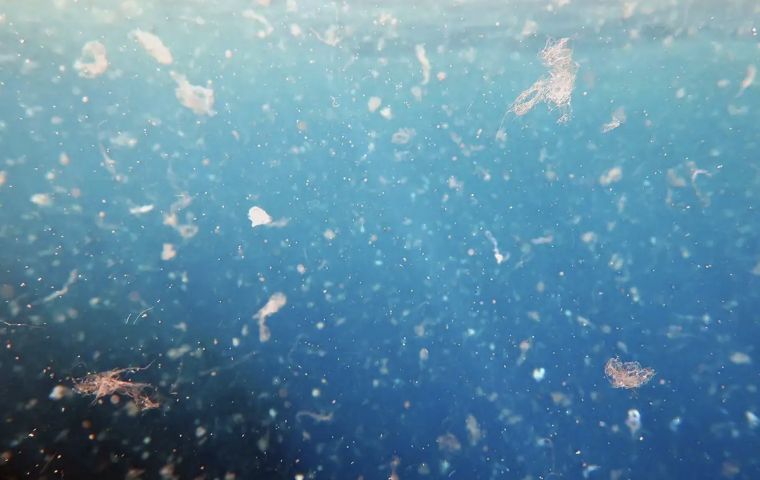MercoPress. South Atlantic News Agency
How do micro-plastic particles differ across the Atlantic Ocean?
 Samples were collected during eXXpedition's pioneering all-women Round the World sailing mission.
Samples were collected during eXXpedition's pioneering all-women Round the World sailing mission. A new study, published in Marine Pollution Bulletin, has found the waters of the North Atlantic gyre contain greater quantities of plastic, such as polyethylene, polypropylene, acrylic, and polyamide, whereas other offshore locations are more associated with PVC and polystyrene.
In one of the planet's five great oceanic gyres, human made marine debris becomes trapped in a circular ocean current that stretches from the east coasts of North America to the west coasts of Europe and Africa.
Seawater closer to land, on the other hand, contains far more diversity in its polymer composition, with researchers saying this could potentially be influenced by its proximity to a variety of sources of plastics arising from land.
The study was conducted by researchers from the University of Plymouth, Mercator-Océan International, and eXXpedition, with samples collected during eXXpedition's pioneering all-women Round the World sailing mission.
Its findings are based on almost 30 samples taken across the Atlantic Ocean, enabling scientists to examine variations in micro-plastic concentration and types within the upper ocean, both on the surface and to a depth of 25 meters.
The overall aim of the research was to provide further data of plastic quantities in the region, and also to cover parts of the ocean where existing data was sparse, such as the eastern boundary of the North Atlantic gyre.
Dr Winnie Courtene-Jones, eXXpedition Science Lead and Post-Doctoral Research Fellow in the International Marine Litter Research Unit at the University of Plymouth, is the study's lead author.
She said: “The presence of plastic pollution within the North Atlantic, and its subtropical gyre, have been reported for 50 years. However, this research shows that the types of polymers differ between different regions of the North Atlantic. The high diversity of polymers identified in inshore waters may simply be down to the numerous and varied source of plastic inputs coming directly from land, Meanwhile the gyre appears to be more closely associated with items that may come from maritime industries or been transported from the countries which border the Atlantic Ocean via ocean currents.”
The water samples collected in the gyre contained on average 0.62 micro-plastics per cubic meter of sea water, compared with an average of 0.19MP/m3 in other areas of open ocean, and 0.4MP/m3 in inshore areas.
By using tracking models developed by experts at Mercator-Océan International, the research team was able to demonstrate how particles found on the surface of the gyre might have reached this region.
Taking into account the hugely varied currents in the North Atlantic, the models suggest they could have entered the sea from anywhere in North America, western Europe and north western Africa.
This, the researchers say, also indicates some of the challenges when attempting to manage the flow of plastic pollution from source to sea.
eXXpedition's Round the World voyage left Plymouth in October 2019 to visit some of the most important and diverse marine environments on the planet with the aim of inspiring a network of change-makers, informing effective solutions with industry and influencing policy change on land.
(*) Journal Reference: Winnie Courtene-Jones, Simon van Gennip, Juliette Penicaud, Emily Penn, Richard C. Thompson. Synthetic microplastic abundance and composition along a longitudinal gradient traversing the subtropical gyre in the North Atlantic Ocean. Marine Pollution Bulletin, 2022; 185: 114371 DOI: 10.1016/j.marpolbul.2022.114371
University of Plymouth. “How do microplastic particles differ across the Atlantic Ocean?.” ScienceDaily. ScienceDaily, 22 November 2022.




Top Comments
Disclaimer & comment rulesCommenting for this story is now closed.
If you have a Facebook account, become a fan and comment on our Facebook Page!